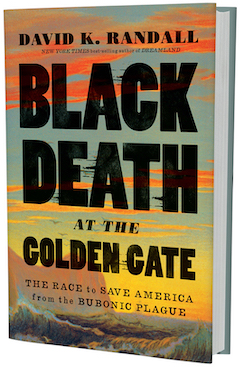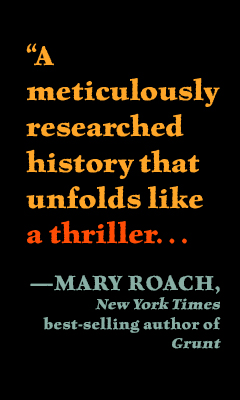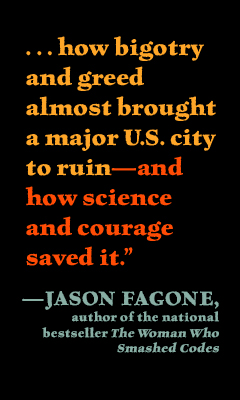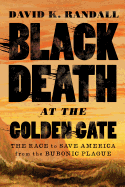Black Death at the Golden Gate: The Race to Save America from the Bubonic Plague
by David K. Randall
David K. Randall has written several excellent, approachable books about science and history: Dreamland: Adventures in the Strange Science of Sleep and The King and Queen of Malibu: The True Story of the Battle for Paradise. His third book, Black Death at the Golden Gate: The Race to Save America from the Bubonic Plague provides a fascinating, in-depth look at a little-known episode in American history. In 1900, a San Francisco health official discovered a swollen black lymph node on the body of a deceased Chinese immigrant named Wong Chut King. This discovery signaled an outbreak of bubonic plague, a disease that had killed millions since its resurgence in the 19th century.
San Francisco's initial response left something to be desired, as city officials and press relied on racist pseudoscience to downplay or even deny the extent of the plague threat. Widespread prejudice against Chinese immigrants led to a quarantine of Chinatown. In turn, distrust for authorities led Chinese immigrants to attempt to conceal victims of the disease. The degree to which racism and poor relations with the Chinese community compromised the response to the plague is a major theme of the book, with Randall tracing the build-up of anti-Chinese sentiment deep into the city's past.
San Francisco developed rapidly in the wake of the Gold Rush as a town where "those who were able to survive in this unconstrained land forged new identities as self-made men...." By 1900, the city was "stuck at a crossroads between its rough past and a new future in which gold was no longer plentiful... an uncomfortable reality in which white men could not easily find work, breeding a generation that felt cheated out of the riches once showered upon their grandfathers." In such an environment, it was easy to blame the problems of white men on Chinese immigrants willing to work for low wages. Randall does not attempt to establish parallels with more recent events, but it's difficult to read these passages without thinking about the ways this cycle has repeated itself numerous times in American history.
One of the men whose judgment was sometimes compromised by racist attitudes was a federal health officer named Joseph Kinyoun, a brilliant bacteriologist with poor interpersonal skills. He recognized the threat posed by plague but lacked the political instincts necessary to organize the city's efforts to combat the disease. His mission was further complicated by the press and governing officials, who ridiculed Kinyoun and even denied the existence of the plague for fear that "any acknowledgment of the disease would narrow their city's future." Randall takes pains to show how this short-sighted logic contributed to the rising death toll. One of the themes of Black Death at the Golden Gate is the collision between economic interests, political interests and the public good. Concerned about negative reaction to the quarantines, California's governor "announced that he would back legislation that would make it a felony to publish anything that suggested that bubonic plague was present in the state." Randall writes: "Under his proposals, the whole of public health... would be moved out of the realm of fact and into politics...."
The story of the bubonic plague outbreak serves as an excellent lead-in for Randall to examine the advances that created modern cities. In Black Death at the Golden Gate, the focus is on the relatively new concept of sanitation. The germ theory of disease was not yet fully accepted, and the danger posed by rats was not understood. A public health campaign was needed, but Kinyoun was not the man to do it. His de facto replacement, Rupert Blue, becomes the hero of the book. Blue was not a brilliant scientist, but he was skilled at winning people's trust. He lacked Kinyoun's arrogance and domineering nature, and he was willing to build relations with the local Chinese community. Blue instituted a successful campaign to cull the city's enormous rat population and improve the conditions that allowed them to prosper. While his efforts were intended to curb the spread of the plague, they also represent an important step forward into the modern era of sanitation.
The outbreak was eventually contained--for the most part--by Blue and a healthy dose of luck. The plague spread relatively slowly in the United States thanks to the prevalence of a particular type of rat flea. Randall emphasizes how close the nation came to an epidemic that might have killed millions. Perhaps as dangerous as the plague itself, however, was the public response. Misinformation, racism, incompetence and short-sighted leadership all contributed to the spread of the disease. Even with the development of better sanitation and vaccines, the human factors that helped create the crisis remain. The hero of San Francisco, Rupert Blue, himself fell short when faced with the enormous challenge posed by the Spanish Flu.
The book closes with an epilogue titled "How Close We Came." Here, Randall sounds a note of warning, reminding the reader that "plague has never been fully eradicated from the country" and that some researchers worry that the continued use of antibiotics might lead to a drug-resistant plague. While Black Death at the Golden Gate recounts a crisis from our nation's past, it carries clear implications for our future. When the next outbreak occurs, we will need to defeat our own worst instincts as well as the disease. --Hank Stephenson








